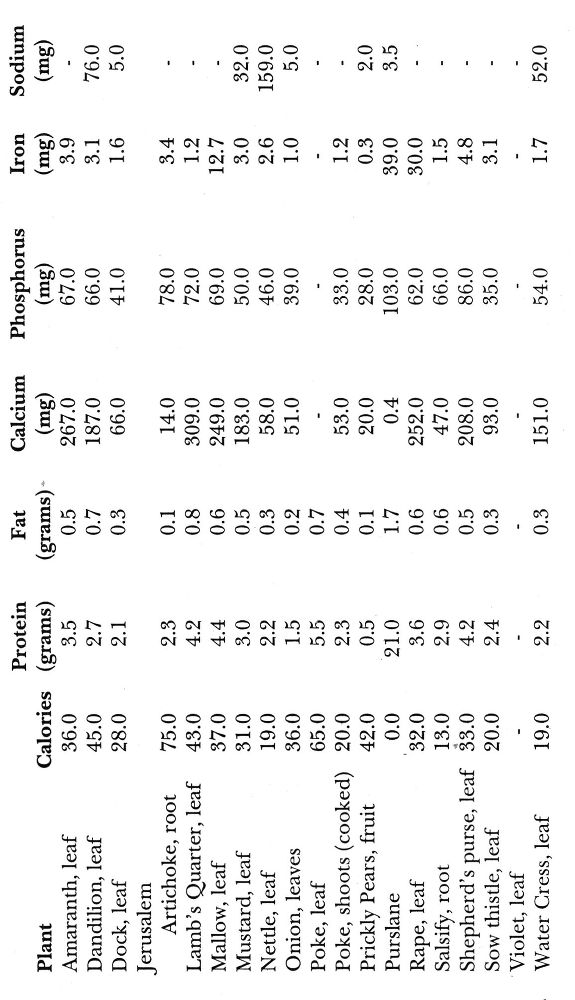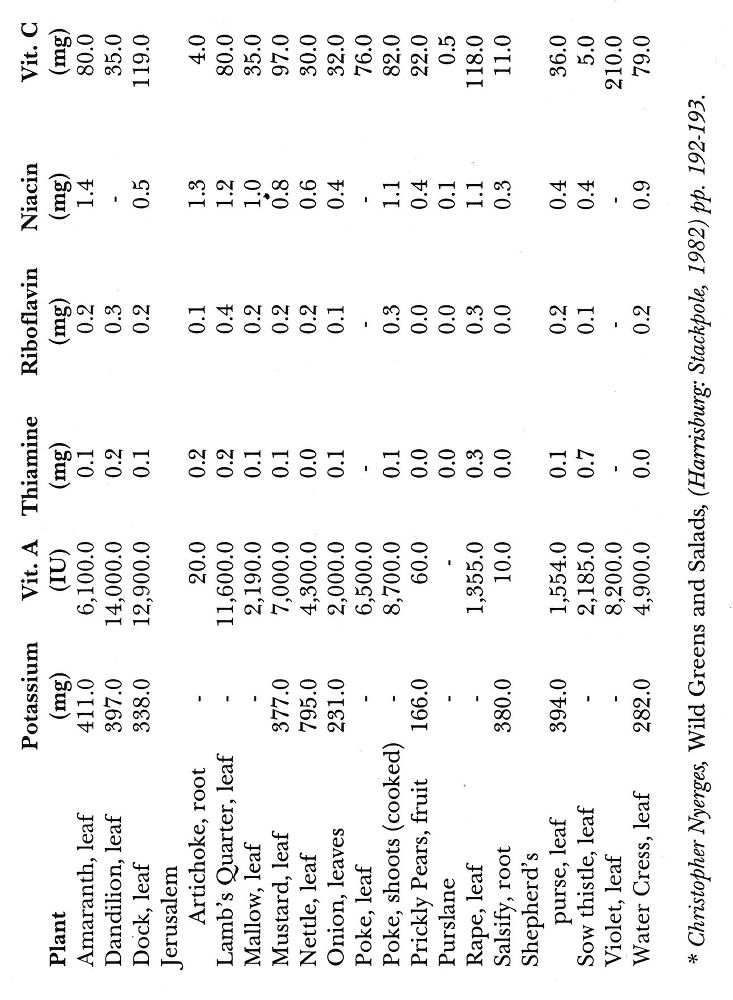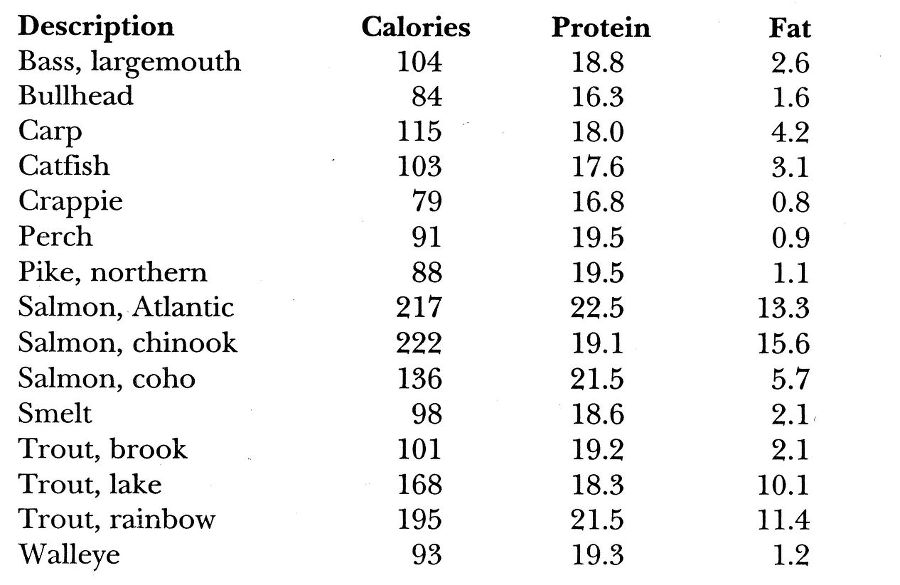Nutritional Composition of Wild Food (per 100 grams)
Dashes denote lack of data for a constituent believed to be present in measurable amounts
Source: Composition of Foods, U.S. Dept. of Agriculture *


Our hunter-gatherer cousins were also physically fit througout their lives. To get their game, the men had to walk until they were in throwing range, after which they may have had to cross thorn-ridden wilderness in a dead heat with, say, an antelope, then cart the beast home. Women had home another several pounds of fruits, nuts and roots. To top it off, shortages were periodically imposed on early people, so they could not have become obese even if their unavoidable exercise were insufficient to prevent weight gain. And it’s not surprising to learn from fossil remains that our remote ancestors possessed great muscular strength, considerably more than is typical of today’s Westerners.
The hunter-gatherer diet was eaten by all people on earth before the coming of agriculture about 10,000 years ago. It was refined over hundreds of thousands of years. So if there is a diet natural to the human makeup, one to which our genes are still best suited, this is it.
Apart from the diet of early Stone Age people, we can evaluate other agricultural people probably chewed tobacco—as do modern-day hunters and gatherers like the Australian aborigines, for example. Tobacco was absent from most of the Old World, however, until the European discovery of America, and the New World was not populated until long after the appearance of anatomically modern humans about 40,000 years ago. Smoking almost certainly postdates the advent of agriculture 10,000 years ago and cigarettes were not even developed until after the Crimean War, in the mid-1850s.
As for alcoholic beverages, if pre-agricultural people had any local breweries they probably operated only seasonally and produced libations by natural fermentation, not distillation. This would have resulted in beer, for example, as opposed to whiskey. Furthermore, studies of recent hunter-gathering peoples show that among them drinking is subject to customs that limit the frequency and place of consumption, degree of allowable intoxication, and types of behavior that will be tolerated. In such circumstances, the solitary, addictive, pathological drinking found in Western and many European societies is almost nonexistent.
Overall, contemporary hunter-gatherers are healthier than we are, at least with regard to those diseases of civilization: heart attack, cancer, stroke, hypertension, obesity, and diabetes—that cause deaths in affluent Western nations. They do not suffer from atherosclerosis, which predisposes us toward heart disease. This is because they are not exposed to cigarettes, eat relatively little fat and generally maintain a high level of aerobic fitness. A diet low in sodium, but containing ample potassium and calcium, keeps their blood pressures constant over the years, while ours tends to rise with age, and they experience little or no hypertension.
Still, it is possible that our poor diet and resulting bad health is not altogether our fault. A taste for fat, like that for sugar, seems to be part of our human makeup. According to the theory of evolutionary surplus, our taste for fats, sweets and salt is a product of natural selection. Built into the taste centers of our brains is a little urge that says something like: “consume as much of those things as you can . . . stock up for a rainy day . . . a shortage will come along and overdraw your fat bank.” Our brains go for what was once, under conditions of limited availability, the evolutionary surplus.5
Extensive mounting evidence, most recently in the form of two studies in the New England Journal of Medicine, points to a strong genetic component in obesity. Most of us have a genetic tendency, from the distant past, to load up on goodies under conditions of abundance.
Of course, some fat (polyunsaturated) is indispensable to our diets and to eliminate it completely would be harmful. But the kinds and amount of fat we eat hurts our health. For example, fast-food (or is it fat-food) chains have prospered on fried foods, which multiply the fat content of a base food item: fried shrimp have more than ten times the fat that boiled shrimp do, and French fries have more than eighty times as much fat as baked potatoes.
Fatty foods can even cause stress in your body and make you less alert; fatty foods take five to seven hours to digest. (Recent reports show foods that are high in carbohydrates release a calming chemical called serotonin, while proteins containing the amino acid tyrosine, increases alertness.)6 Susan Shapiro, Ph.D., an L.A. psychotherapist who counsels patients on nutritional issues and eating disorders, explains that stress can trigger cravings. Most people snack because they think they are hungry when they are really reacting to stress, which prompts a physiological response very similar to hunger. Psychologically, we perceive eating the foods we like as a solution to problems.7
Frankly, if we “are what we eat” as the cliche goes, then as a modern western society, we are in serious trouble. Not only do we not eat the right foods, but we don’t eat them at the right times or in the proper amounts. Eating excessively diverts blood from the brain to the stomach, and the under-eater deprives the brain of essential nutrients.
Nutritional Values of Wild Game and Fish
Nearly all fish and wild game are lower in fat and higher in protein than their domestic counterparts. Venison, for example, has only 6.4 grams of fat per 100 grams of edible meat, while beef has 25 grams of fat per 100 grams of meat. Furthermore, venison contains 33.5 grams of protein per 100 edible grams, while beef has only 17.4. Not to mention the fact that fish and wild game don’t harbor growth hormones or antibiotics as most domesticated meats do. The main concern in eating wild game is possible pesticide poisoning of animals. For example, stay away from deer that range near the Rocky Mountain Arsenal!

Source: U.S. Department of Agriculture, Georgia, and Alaska Cooperative Extension Services. Based on 100 grams of edible meat.
Fish
Wild fish also are lower in fat and higher in protein content than farm-raised fish. Frog legs and turtles are also low in fat and high in protein. Obviously, care should be taken particularly with regard to fish taken from natural water sources to insure that the environment is not contaminated. This is critical in the Great Lakes area of Wisconsin and in New York; states that issue PCB contaminate advisories and, of course, definately don’t eat any fish from Love Canal!

Source: published by the University of Wisconsin Sea Grant Institute. Based on a 3.5 ounce 100 gram portion of raw fish.
Almost everyone has had sudden cravings for an orange, an apple, a piece of meat, a salad, a potato-something nutritious. That is why serious vitamin deficiencies are nearly impossible in healthy people consuming unprocessed food. Nutritional diseases only become manifest when the human diet is artificially manipulated. Until recently that was the result of wars, famines and plagues. Nowadays it is the result of a desire to consume white bread, nitrite-packed hot dogs, rainbow-colored low-fiber breakfast cereal, frozen pizza, chemical-laden Cool Whip, Tang (brought to us by Astronauts), Pringles’ idea for potato chips and hundreds of other factory-made foods. Frankly, for the past fifty or more years, America’s horses, pigs, cattle and sheep have been eating better than its human citizens.